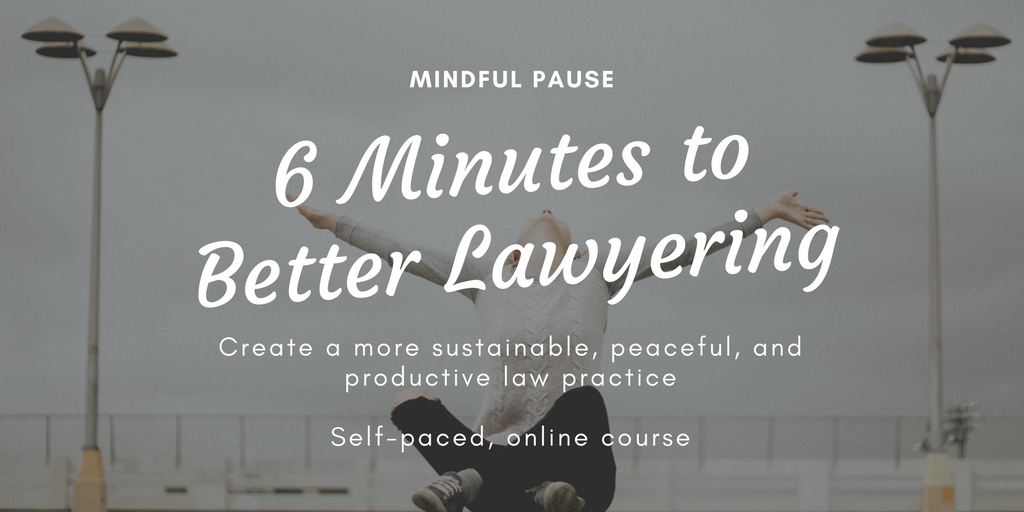This article is an excerpt from The Anxious Lawyer.
As lawyers, we often experience anger. The judge rules against you, opposing counsel is rude or unreasonable, your client goes against your advice and then blames you for the adverse result. Hours, days, or even weeks after the event, you may find yourself stewing over these events and dwelling in anger. [sta_anchor id=”jump” /]This inability to work through or let go of the anger may compound the problem and make you feel even more frustrated or helpless. You may continually feel anger or hostility toward the judge, opposing counsel, or client. How do you cope mindfully in situations where you’re seeing red?
What Is Anger?
Let’s start by looking at anger. Why do humans experience anger? What is it’s function? Anger is an essential survival mechanism. It protects us from harm. It serves as an alert system. It lets us know when we are being mistreated, when we’re under attack, or when our boundaries have been crossed. It also protects others from harm; for instance, when those we care about are in danger or are being mistreated, it propels us to take action.
Since anger is a necessary emotion for survival, it’s important to recognize we don’t want to get rid of it. In our mindfulness practice, we’re focused on working with anger so it reduces our suffering. Consider the last time you were really angry. The feeling of anger was probably very uncomfortable for you. The purpose of being mindful in moments of anger is to release it when it’s no longer serving a necessary function. When you are being mindful, you’re seeing the anger for what it is—an emotional state. You aren’t trying to suppress the anger or deny it’s existence. With mindfulness, you practice directing your attention. So, when the event has passed but you’re still feeling the anger, you can redirect your attention.
Seeing the Anger
When you experience anger, first, ask yourself what function the anger is serving in this moment. For example, when someone cuts you off on the highway, you may feel angry because the other driver put you in a dangerous situation. However, if you find yourself driving all the way to work in anger because of the other driver, the anger is no longer useful. The danger has passed, the threat no longer exists. Now, you’re simply suffering from secondary anger. You may notice yourself feeling angry long after an unfavorable ruling; as you consider whether you should appeal the judge’s decision or not, you continually feel anger. The anger alerts you to the fact that perhaps you feel the judge’s decision was wrong, but anger is probably not a useful emotion when you need to objectively consider the judge’s ruling.
Anger can be triggered just by recalling a situation that angered you in the past, even if it’s been years since the event has occurred. You can blame or target the person, thing, or event that initially caused the anger but the only thing you can change now is your relationship to anger.
Just because you can recognize that anger isn’t serving a useful function doesn’t mean it will automatically fade (although, oftentimes, the intensity may decrease). You may need to spend some time observing and releasing the anger. Using a mindfulness practice, you can observe your anger wash over you like waves. Some waves will be fairly smooth and shallow. Others will be tall and violent. You can practice noticing the waves of anger come and go without getting absorbed in the content of the anger. For example, your mind might be saying, “I am so angry. That client should have listened to me!” See if you can add some distance between the angry thoughts and words by labeling them. You can note, “Ah. There is an angry thought.”
Aside from noticing the angry feelings and thoughts, you can also bring kindness and compassion to how you deal with those feelings and thoughts. Regardless of what situation caused you to be angry, it’s important to acknowledge your emotions. Again, this doesn’t mean you should act out in anger. Just as you would treat a child who is experiencing anger with gentleness, you can practice this with your own anger. Meeting angry thoughts with anger will only lead to additional anger. You can practice saying a phrase such as, “I acknowledge my angry feelings and I treat myself with kindness.” You can also visualize holding the anger with gentleness. Imagine a bubble filled with unconditional love and kindness encircling the angry feelings and thoughts. Alternatively, imagine what you’d say to a dear friend or a loved one if he or she was feeling such anger, frustration, and pain.
Acknowledge the common humanity you share with others in the situation that brought up your anger. Anger is a feeling all human beings experience. In this way, feelings bond us to each other. Even the person who caused your anger has his or her own anger. He or she may be feeling angry about the very situation you’re angry about. Is there any room to acknowledge this common humanity? Can you wish yourself and the other person well?
Feeling the Anger
When you’re feeling angry, it’s helpful to work through it and release it by seeing how it’s impacting your body. Does your stomach or chest feel tight? Does your heart rate increase? Are you tensing your jaw, shoulders, arms, or curling your fists?
By becoming more familiar with how anger feels in your body, you can get better at recognizing the first signs of anger rising. Tapping into your body is a powerful way to know and work through your emotions. Often, you can get completely trapped in your head as you try to intellectually work through an emotion. This often only serves to further escalate your emotion. When you bring the attention into the body, you shift from trying to reason your way through an emotion to noticing and feeling the contours of your emotion. As your become an observer of the emotion as it exists in your body, you also begin to recognize that sensations in the body are consistently evolving.
You may feel heat rising from the core of your stomach all the way up to the face. You can add fuel to this physiological response by adding our narrative, “I can’t believe he objected to that Request for Admissions. He’s just trying to create more work.” Your mind can fuel the fire and further escalate the emotion.
Often, when you are experiencing a very strong emotion, such as anger, fear, hate, or love, you can prematurely jump into action instead of finding a place of calm and clarity first. Resisting the desire to take action can also further provoke our emotion as our mind continues to replay what has occurred. This is the moment where connecting with the breath is crucial. The old adage, “Count to ten before you say something when you’re angry,” works because it forces you to breathe before reacting. This ability to find a place of calm rather than reacting reflexively, understanding your narrative or the story you’re telling yourself about the situation, and getting clear about your own motivation allows you to choose a wise course of action.
As you practice being with strong emotions rather than reacting to them, remind yourself you’re experiencing a difficult moment. Oftentimes, there may be an additional narrative of self-criticism running through your mind for not being strong enough, for letting this person get under your skin, or for having these emotions in the first place. By reminding yourself this is a moment of difficulty and acknowledging your suffering, you’re tapping into your compassion.
Finally, hold anger tenderly. Treat it with kindness. Bring compassion to it. Bring gratitude for it’s function in protecting you. We’ll return to this topic again in Week 7, where we include an exercise for releasing difficult emotions using mantra practice.
Learn to work through difficult emotions. Join me for the Mindful Pause program!


